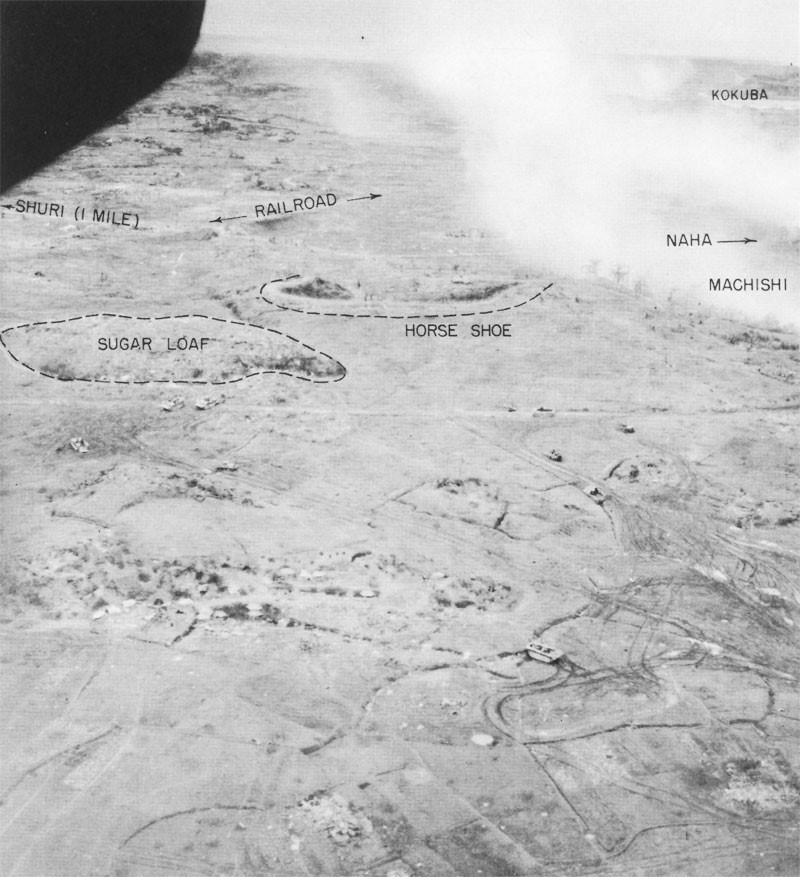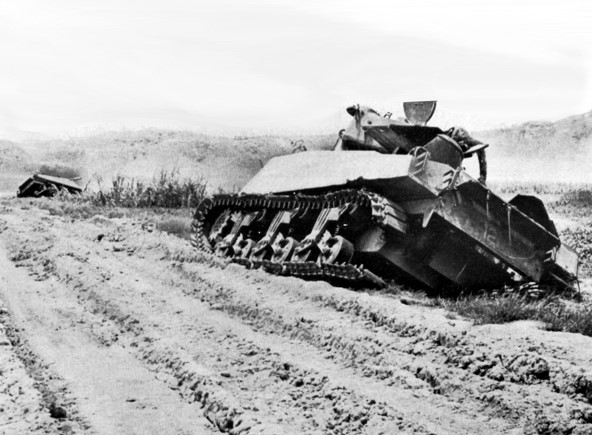Horseshoe and Half Moon Hills
by Laura Lacey
Sixth Marine Division Historian
March 2017
When discussing the Sixth Division on Okinawa, much attention is given to Sugar Loaf Hill and folding the twelve-mile Shuri-Yonabaru line from 12-19 May 1945. Far less attention is given to the two other hills that were part of that sector and that also needed to be taken to successfully fold the Shuri Line. Those two hills – Half Moon and Horseshoe – also faced withering fire during the same period. Although Sugar Loaf may have been the “spearhead,” as James Hallas points out in Killing Ground on Okinawa, Half Moon and Horseshoe served as the base. i The terrain and fortifications and how they were taken – by sure Marine determination – would become part of Marine Corps lore. The whole corridor created difficulties that were almost unimaginable:
"The sharp depression included within the Horseshoe afforded mortar positions that were almost inaccessible to any arm short of direct, aimed rifle fire and hand grenades. Any attempt to capture Sugar Loaf by flanking action from east or west is immediately exposed to flat trajectory fire from both of the supporting terrain features. Likewise, an attempt to reduce either the Horseshoe or the Half Moon would be exposed to destructive, well-aimed fire from Sugar Loaf itself. In addition, the three localities are connected by a network of tunnels and galleries, facilitating the covered movement of reserves. As a final factor in the strength of the position it will be seen that all sides of Sugar Loaf Hill are precipitous, and there are no evident avenues of approach into the hill mass. For strategic location and tactical strength, it is hard to conceive of a more powerful position than the Sugar Loaf terrain afforded. Added to all the foregoing was the bitter fact that troops assaulting this position presented a clear target to enemy machine guns, mortars, and artillery emplaced on the Shuri heights to their left and left rear.” ii

Aerial view of the battle
The goal was to attack an area between Shuri and Naha that was a “1,000-yard-wide corridor.” iii Then the Marines were to head south and east and encircle Shuri castle. The Sixth and First Marine Divisions would be given this task. The area was defended by about 2,500 men of Colonel Seiko Mita’s 15th Independent Infantry Regiment and other attached units. The Japanese soldiers were dug in and had created almost a “perfect static defense.” iv Additionally, for years the area between Shuri Castle and the sea had been home to artillery units, and they had every inch of the ground sited in. They knew how to turn it into a meat grinder, and that is exactly what they did.
The starting place for some of the Sixth Division’s assault up the Shuri valley began on Charlie Hill, which was far more imposing that Sugar Loaf. In fact, Sugar Loaf was so small it did not appear on U.S. topographical maps. Before the war, it had been a popular picnic spot for Okinawans. The Japanese called it Hill 51.2. v The point of attack forward, for much of the 29th Regiment, was to be Half Moon. Half Moon, named for its shape, was also called Crescent Hill; it was a quarter mile southeast of Sugar Loaf. The other hill in this mutual supporting triad was Horseshoe, which was less than 200 yards south of Sugar Loaf and was also referred to as Kings Hill. The sharp depression within the Horseshoe afforded mortar positions that were almost inaccessible.
The problem with taking these hills was the withering interlocking fire the Japanese were raining down on the attempted Marine advance. The men trying to advance on Half Moon were bombarded from caves; on the south slope, mortar fire, small arms and machine gun fire kept them pinned down. However, securing Half Moon and Horseshoe were key to being able to take Sugar Loaf. The next few days would involve continued attempts and withdraws, with 16 May being the worst day of the assault of the Shuri Line. Yet by the next morning, a large portion of Half Moon was held by Marines, and this gave the Marines on Sugar Loaf some relief from the withering fire that had previously rained down on them. On 18 May, a diversionary attack on both Half Moon and Horseshoe drew much of the enemy fire away. This allowed a force of tanks and infantry to rush around the hill’s left flank, attack Sugar Loaf from the rear, and rout the remaining defenders so they were forced to withdraw from Sugar Loaf. This would in turn cause Ushijima to withdraw from the Shuri Line and head south.
There were, of course, the personal stories as well. Stories of courage and of brutal deaths. The fact that men continued to try taking the hills while walking over the bodies of fallen enemies and fellow Marines still seems like an unbelievable nightmare. Conditions were unbearable. It was the rainy season, and that made the conditions for the living – and the dead – much worse. Tanks were bogged down, so supplies had to be brought to the front by hand. Dead bodies sunk in the mire and attracted flies, which was a continual reminder to the troops of what might be in store for them. Eugene Sledge, a member of the First Marine Division that was busy rolling up the other side of the Shuri Line, wrote about the horrible conditions that spring on Okinawa in With the Old Breed: “Cold rain caused the soldiers’ skin to shrivel and whiten from exposure, while infiltrators ensured that few Marines ever caught more than a moment of rest. Incidences of combat fatigue soared.” Sledge, who had survived grisly combat at Peleliu, concluded that Okinawa’s Wana Draw “was the most awful place conceivable for a man to be hurt or to die.” vi

Many of the men have expressed their belief that the nights were somehow the worst, yet often the most spectacular. Naval ships “softened up” the forward areas, while flares lit the night sky. In On the Point of the Spear, Jim White (29th Mar-3-G) writes about the night sky during May 1945. He recounts that the sky was lit by parachute flares, as both sides tried to turn the night into a usable battle field – allowing Americans and Japanese alike to look for enemy movement. Continues White, “Since flares were point sources of light, the shadows those moving lights caused sometimes gave strange appearances to ordinary objects as the flares approached the ground.” The Marines were warned that if caught in the light, it was best to stay still. The time could seem much longer when one was so exposed! vii Night also meant that a Japanese soldier might sneak out of those interlocking caves to get behind American lines and kill Marines in their foxholes.
The aftermath of the battle for the Shuri Line left havoc in its wake. Eugene Sledge and the First Marine Division would end up occupying the area known as Half Moon, and the area seemed to Sledge like a living nightmare – a true No Man’s land, except that this one was covered in dead bodies. Perhaps a better way to describe it would be a No Living Man’s Land. The infantry units of the Sixth were decimated. Jim White’s unit, for example, returned from Half Moon to Charlie Hill with only 20 men left out of some 240 who had landed. Only one officer was left and he had “cracked up.” That would be another price of the battle. Brutal conditions and endless days in continual peril left more than 1,000 men in the Sixth suffering from combat fatigue.
The last battle of the Pacific – Okinawa – will always be known for mud and death and trapped civilians and for Sugar Loaf. However, Asa Kawa, Wana Draw, Charlie Hill – and of course Half Moon and Horseshoe Hills – were also important in pushing the Japanese Thirty-Second Army off the Shuri Line and ultimately ending the Battle of Okinawa.
_________________________
i Hallas, p. 54
ii 6th Mar Div SAR, Ph III, Part III, 5
iii Hallas, p. 34
iv Ibid, p. 54
v http://articles.latimes.com/1995-03-26/news/mn-47346_1_dog-tags-okinawan-water-tower
vi http://www.historynet.com/battle-of-okinawa-the-bloodiest-battle-of-the-pacific-war.htm
vii White, p 24-25
Bibliography
n.d. “6th Mar Div SAR, Ph III, Part III, 5”
Hallas, James H. 1996. Killing Ground on Okinawa: The Battle for Sugar Loaf Hill. Ct.: Praeger publisher.
Smith, Donald. 1995. LA Times. 3 26. Accessed 1 26,17. http://articles.latimes.com/1995-03-26/news/mn-47346_1_dog-tags-okinawan-water-tower.
White, James. n.d. “On the Point of the Spear.” Sixth Marine Division website.
Wukovitz, John. 200. “HistoryNet.com.” HistoryNet. Accessed 1 27, 17. http://www.historynet.com/battle-of-okinawa-the-bloodiest-battle-of-the-pacific-war.htm.

